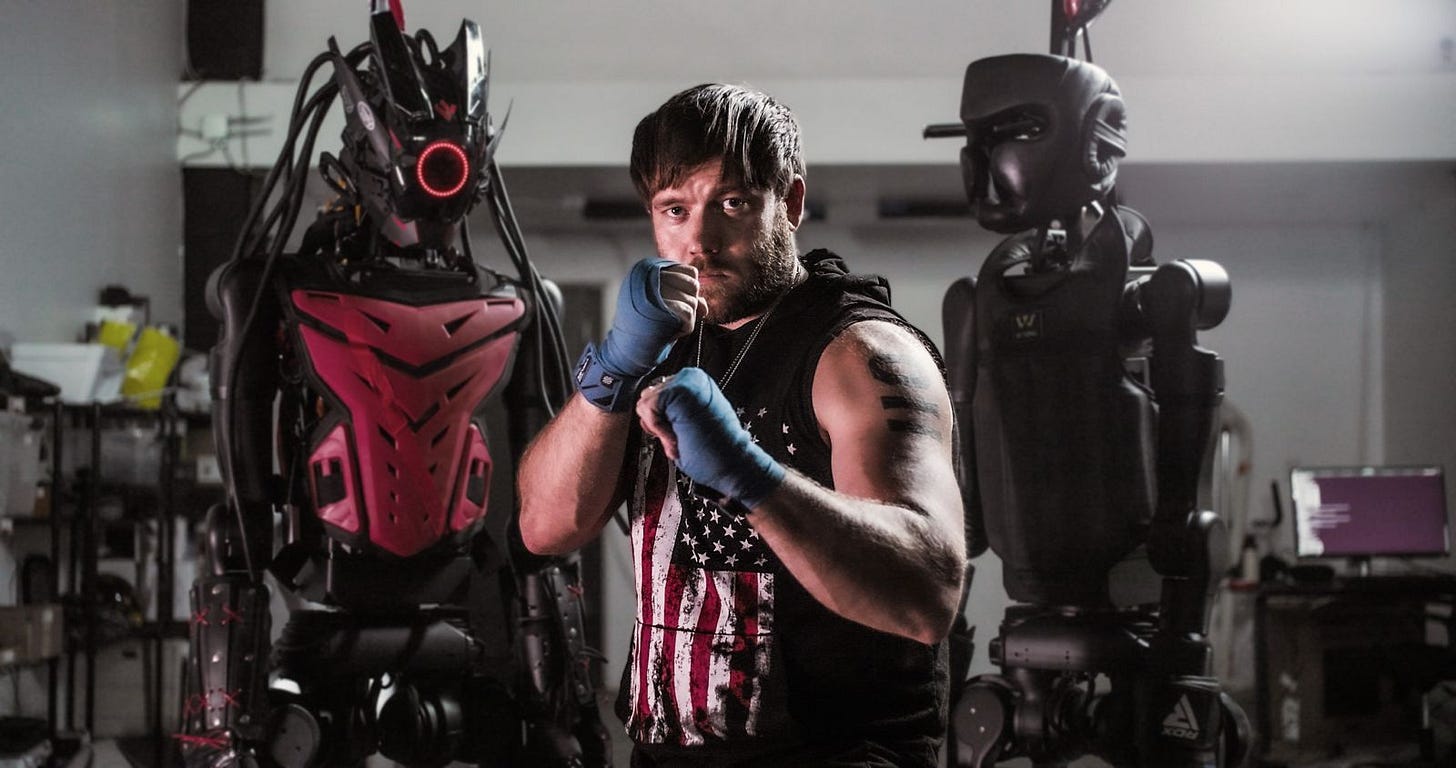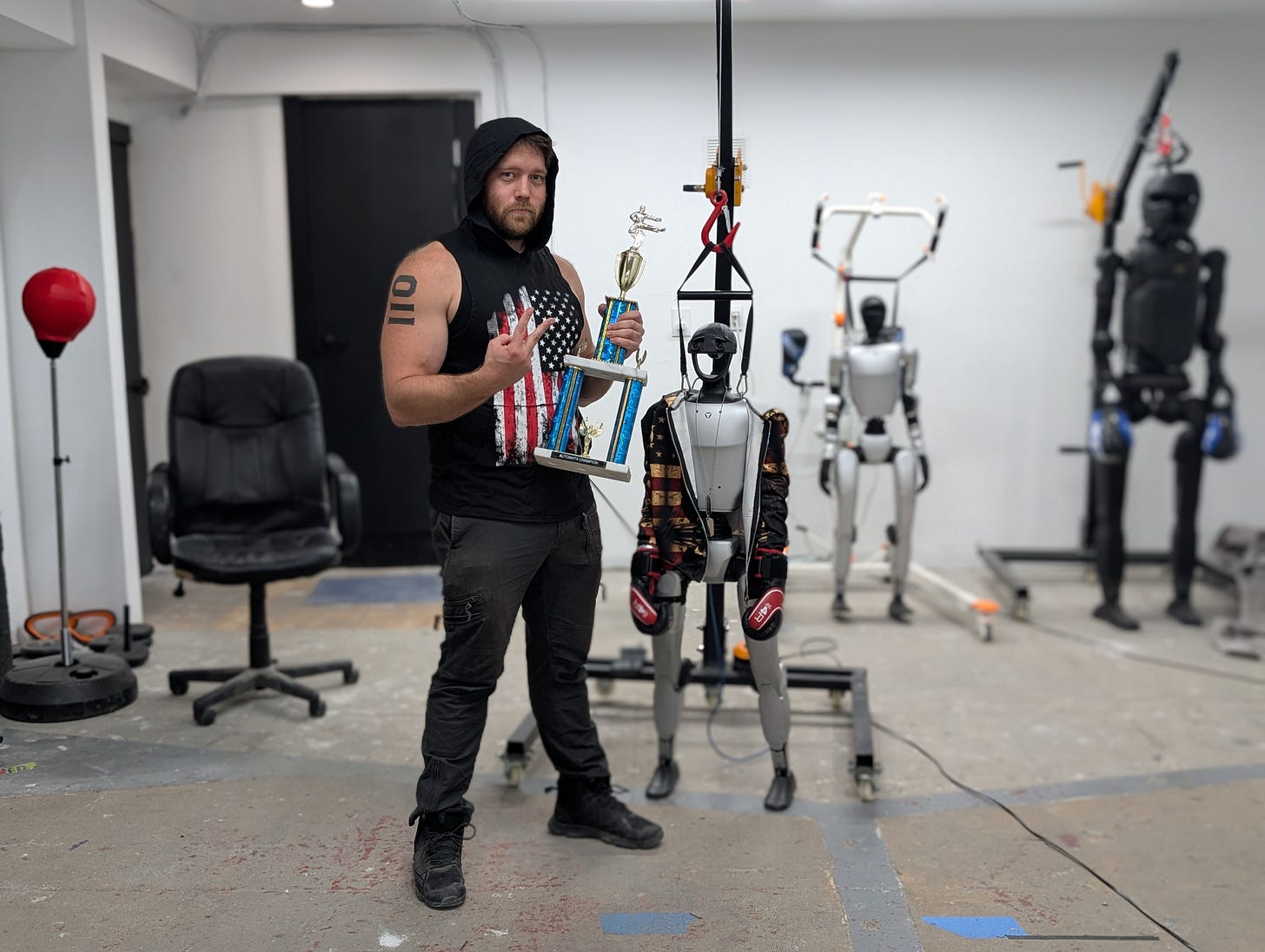Exclusive: Inside San Francisco's Robot Fight Club

For the past few months, Cix Liv – real name – has been operating his company REK out of a no-frills warehouse space off Van Ness in San Francisco. The office has a couple of makeshift desks with computers and a bunch of virtual reality headsets on some shelves. More to the point, REK also has four humanoid-style robots hanging from gantries, and they’ve been outfitted with armor, boxing gloves, swords and backstories.
These machines represent the start of a robot fight club for Liv and his small REK team. They’re at the vanguard of a movement taking place in San Francisco to create a new sport in which robots piloted remotely by people will do battle inside of cages. This sport would mix flavors from mixed martial arts, pro wrestling, the tech world and anime, and, in so doing, would intermingle skill and theater in equal doses. “This is going to be the next UFC,” says Liv. “When this guy's walking around and he has full swords, you can feel the pounding in the ground. You know deep in your soul that this thing could kill you. It’s like when you see a lion or something and the hairs go up on the back of your neck. Once people can really feel this and see this, it’ll be fully mainstream.”
We’ve obviously had robot competitions for years. BattleBots started back in the 1990s, giving hardware nerds a chance to show off their cool contraptions. Those bots, though, were mostly ground dwellers and gimmicky. Now, however, we’re amid the rise of humanoid robots being built by lots of start-ups in the U.S. and, more notably, China. The humanoids bring with them the chance to create a combat sport that looks more familiar to mainstream viewers and the opportunity for better storytelling as we anthropomorphize the bots and develop tales for their pilots.
Some early stabs at these robot battle competitions have taken place recently in San Francisco. Two underground, invite-only events have been held in the parking garage of a downtown building as part of the Ultimate Fighting Bots (UFB) league. Pairs of robots squared off against each other, while a couple hundred people cheered them on from the sides. During intermissions at the first fight, humans stepped into the ring to chase each other with tasers while the fighters prepared their bots for the next battle. (Yes, really.)
The people behind UFB are Michael Cho and Xenia and Vitaly Bulatov, who are married. Cho is a longtime entrepreneur who has been working in the robotics field for years and originated the UFB concept. The Bulatovs also work in the robotics realm and have been organizing the events in San Francisco and pumping social media full of clips from their contests.
The scene is reminiscent of the early parts of the movie Big Hero 6 in which people of all types turn up in shady lairs with their battle bots while onlookers imbibe and gamble. Only the backdrop for that movie was San Fransokyo, and San Fransokyo was edgier and had better bots. These first competitions have been somewhere between exciting and farcical with the robots overheating and bumbling around in between their moments of ferocity. Liv has been the burgeoning star of these fights, winning the first competition and then shifting into a sort of Joe Rogan announcer role for the second, and he thinks he has a plan to uplevel the competitions.
 Cix Liv with his trophy from the first robot battle
Cix Liv with his trophy from the first robot battleLIV IS a large, brawny man who favors muscle tees that promote his biceps. He grew up in the worlds of online gaming and virtual reality. His name is, in fact, a gaming handle, and he made it legal after an identity theft incident. “I called some agency and they said that I could have my credit frozen for the rest of my life or legally change my name,” he says. “They meant the second option as kind of a joke. But, I was like, ‘Fuck it. I’m Cix now.’”
The Liv part is a nod to a company Cix founded in 2016 that let people livestream their virtual reality sessions. The technology developed by the company (LIV) stood as one of the first major efforts to transport the action taking place inside a VR headset out onto a screen for other people to see. Many people consider LIV videos to be the reason that the game Beat Saber took off as a viral success. And VR is now key to REK’s robot combat sport plans.
In REK’s idealized vision, pilots will don VR headsets, slide their arms into combat controllers and enter a virtual fighting cockpit. The pilots will then be able to initialize a series of attacks that are translated by software into movements carried out by the robots. We’re talking full-on punches and slaps and swings, and we’re talking about sword-wielding robots trying to butcher each other as god intended.
The technology required to make all this work is somewhere well beyond daunting. REK has already started training AI models on fighting moves gathered from existing data sets and videos and has been converting that training into maneuvers that can actually be performed by the bots. It’s also built an early prototype of its VR software that gives the pilot a holographic view of a robot’s body, surroundings, health and other performance metrics.
One problem for REK and anyone else that wants to get into this sport is that the current humanoids on the market aren’t really made for fighting. The ones being used most often in the San Francisco fights so far come from Booster Robotics. They’re the size of children and weigh 30kg each. The bots do have some balancing and fighting skills built in but tend to overheat when their actuators are fired in quick succession for, say, a flurry of jabs. To get around this overheating issue, the robots lower their torque automatically, which then lessens the power of the jabs. These robots also can recover pretty well when they’re falling forward but do a bad job of recovering when they’ve been pushed back.
REK has focused on using bots made by Unitree Robotics. It has two mid-sized bots and then two larger bots that weigh about 90kg each. These robots have a wide range of motion and can even come with some built-in boxing skills. Still, they’re not general-purpose fighters either and suffer from balancing issues as well. The big ones cost up to $100,000 each, and they’re usually found in university and corporate settings where they’re being used for research rather than as fodder for combat sports training.
Both Booster and Unitree are based in China, which is outpacing the U.S. when it comes to humanoid robots. The key technology on these systems is the actuators that control the movements in the limbs, and China is the actuator capital of the world. When REK wants to make a software change to the bots or order a replacement part, it’s often gated by dealing with overseas engineers and shipping schedules. “It would help if I knew Mandarin,” Liv says.
What REK really has going for it is its vast virtual reality experience. There’s Liv and then the company’s chief technology officer Amanda Watson. Before REK, she worked at Oculus/Meta for more than seven years, spending some of that time sitting alongside John Carmack. Watson led the development of much of the Link technology that made it possible to connect a VR headset to a gaming PC via Wi-Fi, which let players stop being tethered via cables to their computers. Also on the REK team is Nima Zeighami, who has spent more than a decade working on virtual reality, augmented reality, and game engines, and did a stint at Leia building cameras and light-field displays.
 Amanda Watson being a VR guru
Amanda Watson being a VR guruWatson has a track record of approaching the latency problems that can plague VR in novel ways, which could be key here. REK must make the pilots’ moves feel natural and real-time if the fights are to resemble true combat sports. “If you know the real issues associated with latency, then you can control for them,” Watson says. “A good programmer can make it look as though things are happening very responsively.”
IN JULY, Liv posted a video in which one of REK’s robots went nuts. The team had sent a full-body command to the robot, but its feet weren’t touching the ground at the time because it hung from a gantry. The robot could not depend on its usual stability mechanisms and compensated by flailing around widely. Liv had genuine fear and panic on his face as he approached the hulking mass and tried to decide how to stop it from wrecking itself and the REK office and its humans.
This video told me two things. First, it’s obvious that the journey toward a robot fighting league will be an arduous one. The humanoid robots are not yet being mass produced, so they’re expensive and the costs for experimentation – accidental or otherwise – will be high. Add on all the software and virtual reality work that needs doing, and the slog becomes very real. Second, it told me that Liv might just have the media savvy needed to create a robot fighting league. He posted this low moment for REK on purpose, knowing it would go viral and generate interest in the cause.
While Liv has been participating in the Ultimate Fighting Bots events, it’s unclear if he and REK will stay linked to UFB or go off and create their own league. (We’ll have more on the UFB backers soon.) At the moment, Liv is convinced that REK is the only company working on the underlying technology components required to turn robot battles into a popular, spectator sport. “We’re building all this really complicated tech to make the mass consumption of this possible,” he says. “Our method of controlling the robots will be more capable than what anyone else is doing.” In one scenario, REK creates the software and hardware foundation of this new sport and sells its technology to others.
So far, REK has been mostly self-funded. “I’d made some money from a prior start-up and was deciding whether to get a mortgage on a house or have robots,” Liv says. “I chose to do this instead of having a house.”
During my two-day stint hanging out at the REK office, I would see Liv light up again and again when talking about what future fights could look like. His mind goes to patriotic storylines. “You could have Japanese fighters show up with a samurai and battle against a robot outfitted in chainmail from the U.K.,” he says. “Or you could have Tesla’s Optimus versus Unitree. If Elon was taking on China, it would be broadcast to the whole world, and you would literally have state-level engineers trying to ensure their country wins.”
Liv also likes the opportunities this type of sport offers for unconventional competitive pairings. Men versus women. Kids versus adults. The young versus the old. “It would be the first combat sport where you have parity and everyone is competing on a level playing field,” he says.
REK has already been building out the backstories for its bots. One of them is Derek – the robot who doesn’t want to fight because he’s peaceful at heart but has to fight to earn his freedom. He’s the one that spun out of control. “Poor Derek just wants to be free,” Watson jokes. Another machine is named Rambot and has dog tags belonging to John Rambo.
China is clearly ahead on producing the hardware that these bots need but, so far, has not embraced the full-on fighting aspect. Companies there have been doing sedate demos. Liv is convinced that San Francisco and the U.S. will be the robot battling leaders. “China is ahead on production and engineering,” Liv says. “But the U.S. is still the cultural battleground for the world. The winner of the robot fights will probably be an American using Chinese robots – at least for now.”
In its current incarnation, the technology is cool but unpolished. The robots can look goofy at times, and they’re far from executing long series of sophisticated moves. The scene itself, though, is exciting, and there is a feeling of inevitability to all of this. Like, obviously we’re going to have humanoids try and slaughter each other. And obviously people will want to be jacked in controlling these things as the slaughter takes place. If nothing else, it seems better to have bots damaging themselves than humans damaging themselves. “Gen Z doesn’t want to get punched in the face anymore,” Liv says. “Parents don’t want their kids getting concussions. The future of combat sports is robots.”
Of course, the bots will probably have their own opinions on all of this soon enough.